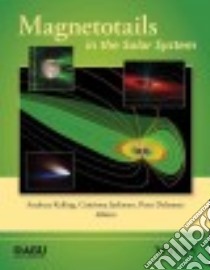Magnetotails in the Solar System - 9781118842348
Un libro in lingua di Keiling Andreas (EDT) Jackman Caitriona M. (EDT) Delamere Peter A. (EDT) edito da Amer Geophysical Union, 2015
- € 171.10
- Il prezzo è variabile in funzione del cambio della valuta d’origine
All magnetized planets in our solar system (Mercury, Earth,Jupiter, Saturn, Uranus, and Neptune) interact strongly with thesolar wind and possess well developed magnetotails. It is not onlythe strongly magnetized planets that have magnetotails. Mars andVenus have no global intrinsic magnetic field, yet they possessinduced magnetotails. Comets have magnetotails that are formed bythe draping of the interplanetary magnetic field. In the case ofplanetary satellites (moons), the magnetotail refers to thewake region behind the satellite in the flow of either the solarwind or the magnetosphere of its parent planet. The largestmagnetotail of all in our solar system is the heliotail, the “magnetotail” of the heliosphere. The variety of solar wind conditions,planetary rotation rates, ionospheric conductivity, and physicaldimensions provide an outstanding opportunity to extend ourunderstanding of the influence of these factors on magnetotailprocesses and structures.
Volume highlights include:
- Discussion on why a magnetotail is a fundamental problemof magnetospheric physics
- Unique collection of tutorials on a large range of magnetotailsin our solar system
- In-depth reviews comparing magnetotail processes at Earth withother magnetotail structures found throughout the heliosphere
Collectively, Magnetotails in the Solar System bringstogether for the first time in one book a collection of tutorialsand current developments addressing different types ofmagnetotails. As a result, this book should appeal to a broadcommunity of space scientists, and it should also be of interest toastronomers who are looking at tail-like structures beyond oursolar system.
Informazioni bibliografiche
- Titolo del Libro in lingua: Magnetotails in the Solar System
- Lingua: English
- Autori : Keiling Andreas (EDT) Jackman Caitriona M. (EDT) Delamere Peter A. (EDT)
- Editore: Amer Geophysical Union
- Collana: Amer Geophysical Union (Hardcover)
- Data di Pubblicazione: 02 Febbraio '15
- Genere: SCIENCE
- Pagine: 407
- Dimensioni mm: 304 x 228 x 25
- ISBN-10: 1118842340
- EAN-13: 9781118842348


